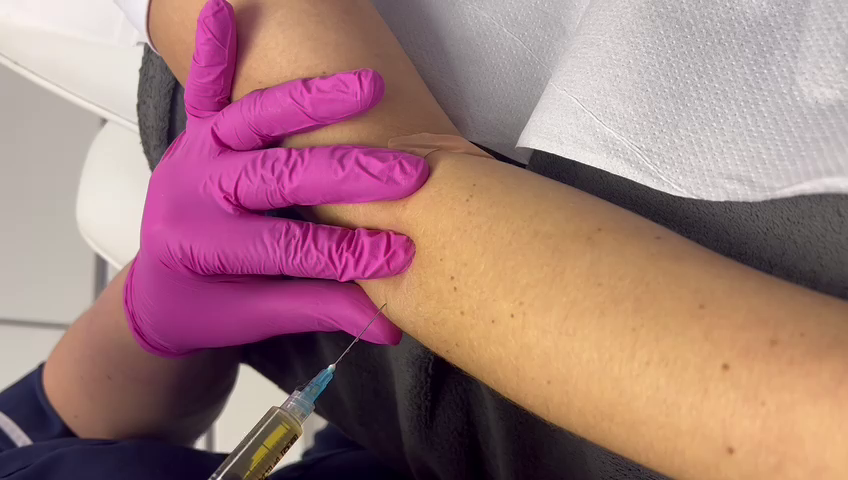
PRP Joints and Soft Tissue Injections Types, Uses and Risks
What is PRP and what does it do?
PRP is an innovative treatment that can stimulate a strong and long-lasting healing and pain-relieving response when injected into an injured part of the body. It has most commonly been used in treatment of knee osteoarthritis.
Clinical studies have reported pain relief and improved function for over a year in patients who are on the waiting list for total knee replacement. Sports injuries as well as degenerative joint or tendon conditions can be successfully treated with PRP.
Platelets consist of special proteins called growth factors and cytokines, which help with our body's healing process and provide pain relief. PRP has a high concentration of plasma and platelets. PRP consists of approximately 5 times the concentration of growth factors and cytokines found in normal blood.

Thus, PRP stimulates the regeneration of tissues including:
-
Joints and its components
-
Tendons
-
Ligaments
-
Muscles
-
Cartilage
Platelets are normal blood components, and alone do not have any restorative or healing properties rather they secrete substances called growth factors and other proteins that regulate cell division, stimulate tissue regeneration and promote healing. Platelets also help the blood to clot after cut.
PRP Injections are widely used to treat the Joints issues, such as Osteoarthritis all the human joints. The effects depend on the number injections and degenerative changes inside the joint.
PRP injections may be able to treat a range of musculoskeletal injuries and conditions. For example, chronic tendon injuries such as tennis elbow or jumper’s knee can often take a long time to heal, so adding PRP shots to a treatment regimen can help to stimulate the healing process, decrease pain and enable a return to activities sooner.
Clinical tests for PRP
Extensive research has shown that PRP is highly effective in the treatment of Mild to Moderate (Grade I-III) Knee Osteoarthritis. The research consistently shows that a course of PRP injections provides significantly greater long term, often 1 year or more pain relief and improved function than other common injections, including cortisone and Hyaluronic Acid. As a result, it is now widely accepted that PRP should be considered as a primary injection therapy for knee pain, that is not controlled by more conservative measures.
ATP Physio Clinic Injections offered
For all our patients we offer PRP:
-
Joints Injections
-
Tendon injections
-
Muscle Injections
-
Ligament Injections
-
Any Soft Tissue injections
In some cases, we perform Tendon Injection, Muscle Injection and Joint Injection at the same time, apply to the same area.
Very good example can be the Hip Injection, where the main issue is not only Hip Joint but also Greater Trochanteric Bursitis and very often gluteus maximus tendinopathy.
We encounter situations like this very often and can face it efficiently.
Common PRP soft tissue injections
-
Osteoarthritis Joints knee, hip, wrist, shoulder…
-
Joints Arthritis
-
Achilles Tendinopathy
-
Plantar Fasciitis
-
Calcaneal Spur
-
Rotator cuff tears and strains
-
Frozen Shoulder, Shoulder Bursitis
-
AC Joint Injury
-
Tennis Elbow, Golfer’s Elbow
-
Carpal Tunnel Syndrome, hand wrist pain
-
De Quervain’s Syndrome
-
ACL and knee injuries
-
All Knee ligaments injuries
-
Muscle tears and strains
-
Tendinitis and ligament sprains
-
Knee, ankle sprains
-
Noisy joints
-
Tennis Leg Syndrome
-
Foot and Ankle tendonitis and bursitis
-
Old Muscle injuries
-
Long term muscle spasms with no neurology background
-
Any sports injury
Benefits PRP Joints and Soft Tissue Injections
PRP Joints Injection is widely used to treat damage joints, especially in a grade II and III. In right time injected can significantly delay the degeneration process and rebuild the damage joint components.
Platelet-Rich Plasma therapy can be used for the treatment of a long list of tendon, muscle and ligament injuries that have occurred as a result of tissue degeneration, excessive sports activities, such as those done by professional athletes. Any parts of the body can be treated with PRP which means the injection technique is applicable no matter which region the injury affects.

Here are some of the other benefits which patients will enjoy through PRP therapy:
-
Repair damaged cartilage, tendons, ligaments, muscles, bones
-
Stimulate the formation of new cartilage
-
Inhibit inflammation and slow down the progression of osteoarthritis
-
Speed up the healing processes in the injured area
-
Accelerate regeneration process
-
Increase the production of natural lubricating fluid in the joint, thereby easing painful joint friction
-
Significantly reduce pain sensation
-
Shorter downtime
-
Pain relief
-
Lower risk of complications (compared to surgery and medications)
-
Zero scarring
-
No incision
-
Effective regeneration of tissue
PRP Therapy Risks and Side Effects
A PRP injection is a low-risk procedure and does not usually cause major side effects. The procedure involves a blood draw, so you should make sure you are hydrated and have eaten beforehand to prevent feeling lightheaded. After the procedure, you may experience some soreness and bruising at the injection site.
Because PRP injections are made up of your own cells and plasma, the risk of an allergic reaction is much lower than with other injectable medications like corticosteroids.
Number of injections
All therapy doesn’t matter is it a antibiotics, Physiotherapy or individual therapy should be done in series.
With PRP injections the same rule applies.
The Injections should be done together three times per injected area, in gaps 3-4 weeks between.
Number of minimum injections is individual, but optimal number is 3 injections. In some cases when the injury lasts long time more injections may be required.